UNITED STATES
SECURITIES AND EXCHANGE COMMISSION
Washington, D.C. 20549
FORM N-CSR
CERTIFIED SHAREHOLDER REPORT OF REGISTERED
MANAGEMENT INVESTMENT COMPANIES
Investment Company Act File Number: 811-04521
| T. Rowe Price State Tax-Free Income Trust |
|
| (Exact name of registrant as specified in charter) |
| |
| 100 East Pratt Street, Baltimore, MD 21202 |
|
| (Address of principal executive offices) |
| |
| David Oestreicher |
| 100 East Pratt Street, Baltimore, MD 21202 |
|
| (Name and address of agent for service) |
Registrant’s telephone number, including area code: (410) 345-2000
Date of fiscal year end: February 29
Date of reporting period: February 29, 2016
Item 1. Report to Shareholders
| Maryland Short-Term Tax-Free Bond Fund | February 29, 2016 |
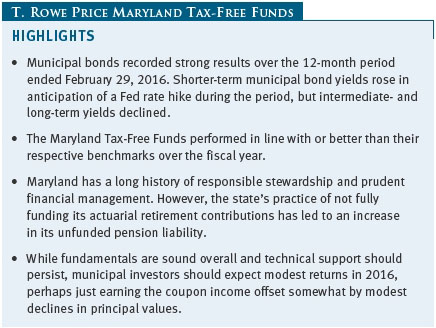
The views and opinions in this report were current as of February 29, 2016. They are not guarantees of performance or investment results and should not be taken as investment advice. Investment decisions reflect a variety of factors, and the managers reserve the right to change their views about individual stocks, sectors, and the markets at any time. As a result, the views expressed should not be relied upon as a forecast of the fund’s future investment intent. The report is certified under the Sarbanes-Oxley Act, which requires mutual funds and other public companies to affirm that, to the best of their knowledge, the information in their financial reports is fairly and accurately stated in all material respects.
REPORTS ON THE WEB
Sign up for our Email Program, and you can begin to receive updated fund reports and prospectuses online rather than through the mail. Log in to your account at troweprice.com for more information.
Manager’s Letter
Fellow Shareholders
Tax-free municipal bonds strongly outperformed taxable bonds in the 12-month period ended February 29, 2016, with the Barclays Municipal Bond Index returning 3.95% versus 1.50% for the Barclays U.S. Aggregate Bond Index. In fact, munis were one of the best-performing asset classes over the last year, as global equities and other higher-risk assets fell sharply in response to China’s economic deceleration and tumbling commodity prices. Money market yields remained very low over the last year, but they increased toward the end of 2015, as the Federal Reserve raised the overnight federal funds target rate in December for the first time in nine years. Shorter-term municipal bond yields also rose in anticipation of a Fed rate hike, but intermediate- and long-term yields declined. The Maryland Short-Term Tax-Free Bond Fund and Maryland Tax-Free Bond Fund outperformed their peer group averages over the fiscal year, while the Maryland Tax-Free Money Fund performed in line with its benchmark.
ECONOMY AND INTEREST RATES
The U.S. economy expanded at a relatively soft annualized rate of 1.0% in the fourth quarter of 2015, according to the most recent estimates, but the underlying trend of moderate U.S. economic growth seems to remain in place. Jobs growth was solid throughout 2015, averaging more than 200,000 per month, and the national unemployment rate fell to 4.9% in February, its lowest level in eight years. Falling domestic oil production and the strong U.S. dollar have weighed on the manufacturing sector, but weakness in the natural resources and manufacturing segments has not spilled over to the broader economy.
Although broad measures of inflation have been very low due to declining oil and other commodity prices—which is a plus for consumers and many businesses—Fed officials decided to raise short-term interest rates on December 16 because of labor market improvement and their confidence that inflation will return to 2% over the medium term. The new fed funds target rate range is 0.25% to 0.50%; the range had been 0.00% to 0.25% since December 2008. While core inflation (which excludes food and energy costs) is beginning to turn higher, we believe subsequent interest rate increases will be very gradual, as the Fed will likely watch the effects of each rate increase for several months before deciding to act again.
Short-term Treasury and municipal yields increased over the last year, which is not unusual in advance of Fed tightening. Intermediate-term Treasury and muni yields declined, resulting in flatter yield curves in both markets. The 30-year Treasury bond yield was virtually unchanged over the last year, whereas high-quality 30-year muni bond yields declined, resulting in price appreciation that contributed to muni outperformance. With 30-year muni yields above 30-year Treasury yields at the end of our reporting period, long-term municipal bonds remain an attractive option for longer-term, income-oriented investors.
As an illustration of their relative attractiveness, on February 29, 2016, the 2.80% yield offered by a 30-year tax-free general obligation (GO) bond rated AAA was about 107% of the 2.61% pretax yield offered by a 30-year Treasury bond. Including the 3.8% net investment income tax that took effect in 2013 as part of the Affordable Care Act, the top marginal federal tax rate currently stands at 43.4%. An investor in this tax bracket would need to invest in a taxable bond yielding about 4.95% to receive the same after-tax income as that generated by the municipal bond. (To calculate a municipal bond’s taxable-equivalent yield, divide the yield by the quantity of 1.00 minus your federal tax bracket expressed as a decimal—in this case, 1.00 – 0.434, or 0.566.)
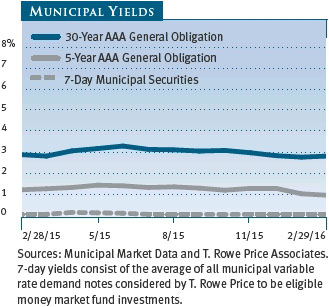
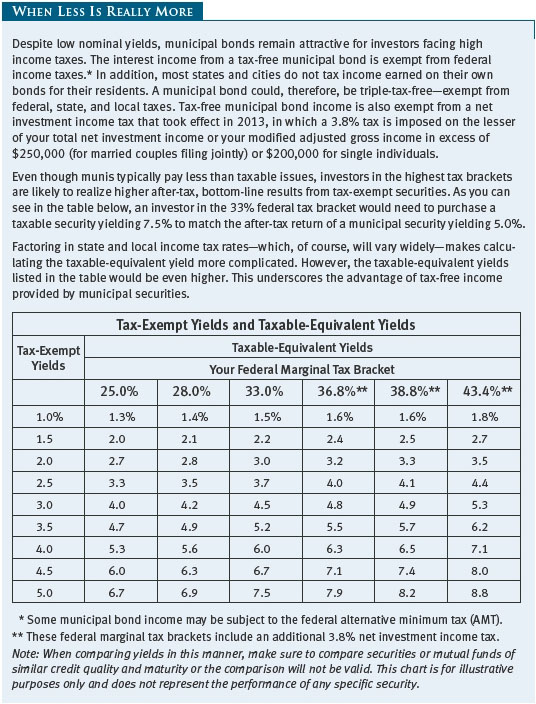
MUNICIPAL MARKET NEWS
Total municipal bond issuance in 2015 was about $398 billion, according to The Bond Buyer, while issuance in the first two months of 2016 was roughly $55 billion. Limited supply and strong demand during the second half of the reporting period created a strong technical environment and bolstered the muni market, even in the face of the Federal Reserve’s December rate hike. While refunding debt rose significantly in the first half of our fiscal year as muni issuers took advantage of low borrowing costs to refinance older, higher-cost debt, year-over-year issuance declined throughout the second half of our reporting period. As for demand, a slow but steady pace of muni market outflows in the first half of our fiscal year reversed and turned into a strong pace of inflows in the second half. Overall, flows into municipal bond funds for the last 12 months were positive.
Generally, fundamentals for municipal issuers remain solid. The overwhelming number of issuers in the $3.7 trillion municipal bond market are acting responsibly—raising revenues, reducing expenses, balancing budgets, and taking steps to address long-term liability issues. Most state and local governments have been very cautious about adding to indebtedness since the financial crisis, and a strengthening economy has helped tax revenues rebound. Over 60% of the market, as measured by the Barclays Municipal Bond Index, is AAA or AA rated.
Although the market is overwhelmingly high quality, many states and municipalities are grappling with underfunded pensions and other post-employment benefit (OPEB) obligations. New reporting rules from the Governmental Accounting Standards Board are bringing greater transparency to state and local governments’ pension funding gaps, long-term risks that investors often overlooked in the past. We believe the market will price in higher pension risks over time, as the magnitude of unfunded liabilities becomes more conspicuous.
The Commonwealth of Puerto Rico, which experienced its first official default when it failed to make the full payment due on its Public Finance Corporation bonds at the beginning of August, remained in the headlines in the last six months. Puerto Rico defaulted on approximately $37 million of the roughly $1 billion in debt payments due on January 1, 2016. The default had little impact on the broader muni market, as Governor Alejandro Garcia Padilla had warned that another default was coming in the absence of help from Washington. Near the end of our reporting period, the governor signed the Revitalization Act, which will allow the Puerto Rico Electric Power Authority (PREPA) to restructure nearly $9 billion of its debt. T. Rowe Price’s municipal team has long maintained that Puerto Rico’s debt burden is unsustainable and would eventually need to be restructured. We have had no exposure to the commonwealth’s bonds in the Maryland Tax-Free Funds for some time.
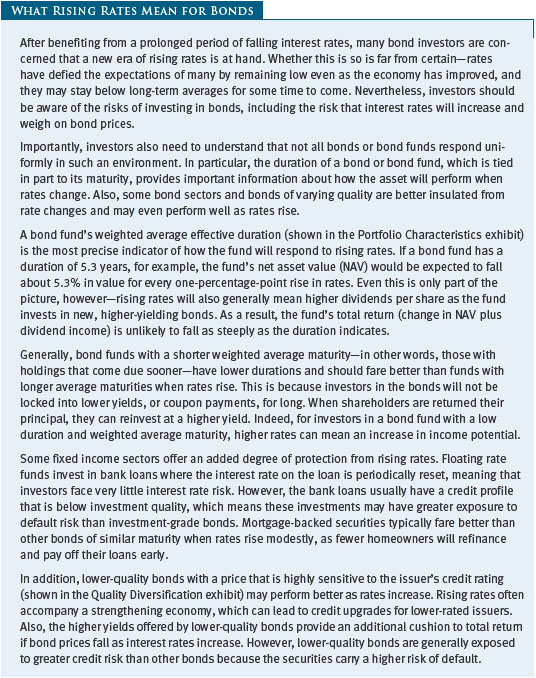
In terms of sector performance, revenue bonds outperformed state and local general obligations over the last year. We continue to favor bonds backed by a dedicated revenue stream over GOs, as we consider revenue bonds to be largely insulated from the pension funding concerns facing state and local governments. Across our municipal platform, we have an overweight to the higher-yielding health care and transportation revenue-backed sectors. Among revenue bonds, transportation and water/sewer were two of the best-performing segments. Resource recovery, leasing, and housing bonds lagged the broader market but still posted positive results. High yield tobacco bonds performed extremely well, outpacing the broad muni market by a wide margin. Longer-maturity municipals outperformed shorter-maturity issues, and lower-quality investment-grade munis generally outperformed higher-quality bonds.
MARYLAND MARKET NEWS
Maryland’s economy remains strong compared with other states. Marylanders are relatively prosperous—per capita personal income represented 126% of the national average in 2014 (the latest available data), ranking it fourth in the nation. The state’s unemployment rate was 4.8% as of January 2016, on par with the national unemployment rate and an improvement from the 5.4% rate in January 2015. Over the past year, Maryland’s employment base grew at a pace that was slightly above the national average.
Although Maryland’s finances improved, with general fund revenues increasing by 6% during fiscal 2015 after lackluster growth during 2013 and 2014, revenues underperformed original budget expectations. Expenses were controlled, yielding a surplus of $175 million, or 1%, in fiscal year 2015. The state has always maintained a good cushion in its rainy day fund—on June 30, 2015, Maryland’s reserve fund held $780 million, representing a solid 4.9% of general fund revenues. The state balanced its budget for fiscal 2016, and the budget was delivered on time.
Maryland’s debt load is above the national average. According to Moody’s 2015 State Debt Medians, the state’s debt burden, at $11.3 billion, is in the upper third when measured by debt per capita and modestly worse when measured by debt to personal income. Debt service as a percentage of the budget remained manageable at 6.0% in fiscal year 2015.
Unfavorably, Maryland’s pension system was only funded at 69% on an actuarial basis as of June 30, 2015. Maryland’s practice of not fully funding its actuarial retirement contributions has led to an increase in its unfunded pension liability. As a result, Maryland faces heavy unfunded liabilities for its pension plans compared with other AAA rated states, at $17 billion as of June 30, 2015—a significant rise from $10 billion as of June 30, 2008. Various modifications to benefits under these programs as well as higher employee contributions have been imposed to reduce liabilities and improve funding, and we are closely monitoring Maryland’s progress in this regard. Liabilities for retiree health programs were also high at $9.4 billion as of June 30, 2015.
Maryland has a long history of responsible stewardship and prudent financial management. The state’s GO bonds are rated Aaa by Moody’s Investors Service and AAA by Standard & Poor’s and Fitch. All three rating agencies maintain stable outlooks.
PORTFOLIO REVIEW
Maryland Tax-Free Money Fund
Your fund returned 0.01% in the 12-month period ended February 29, 2016, which was in line with the performance of the Lipper Other States Tax-Exempt Money Market Funds Average. Yields for investors in the fund remain near zero, despite the Fed’s December rate increase.
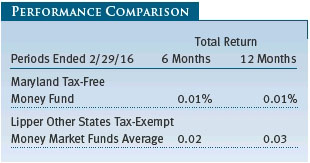
While longer-maturity (six to 12 month) yields have moved somewhat higher, rates in the front end of the yield curve—where the fund must do the bulk of its investing—remain in the low single digits. Overnight and seven-day yields remain unchanged at 0.01% to 0.02%. Longer-maturity yields moved higher by 17 basis points to 0.40%. Although expectations of the future path of interest rates should influence municipal money market yields, the dominant factor suppressing yields remains persistently low supply.
As we have noted in prior shareholder letters, historically low interest rates have encouraged municipal issuers to restructure much of their borrowing to lock in favorable long-term financing, which has come at the expense of short-term financing. As a result, variable rate demand note (VRDN) supply ended 2015 at $178 billion, down 21% from the prior year and 68.6% from the highs in 2007 of $565 billion. The resulting supply/ demand imbalance has been dramatic; municipal money market assets under management ($244 billion) now significantly exceed VRDN supply outstanding, a condition not seen since the 1980s.
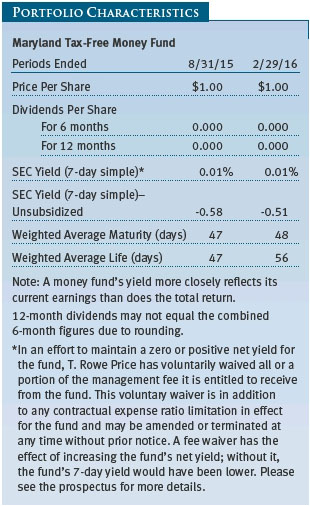
Further contributing to the ongoing technical imbalance, municipalities have seen tax revenues increase as a result of better economic conditions over the last couple of years. This has reduced their need for annual short-term borrowing, which was $34.5 billion in 2015, the lowest in over 15 years and 47% lower than the peak in 2010 of $65 billion. This is good news for municipalities, but bad news for money market funds as these issuers tend to be well-known, liquid names that provide diversification and supply to money market funds starved for new issuance.
Strong credit quality continues to be a feature of the Maryland Tax-Free Money Fund. As a policy, we favor only the most highly rated credits from revenue sectors such as hospitals and housing as well as select general obligation issuers. Some prominent positions in the portfolio include Johns Hopkins Health, Maryland Community Development Administration, Baltimore County, and Montgomery County. (Please refer to the fund’s portfolio of investments for a complete list of our holdings and the amount each represents in the portfolio.)
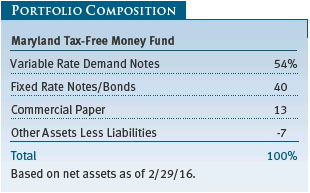
While the Fed has started raising interest rates, the path toward rate normalization is expected to be long and slow. As always, we remain committed to managing a diversified portfolio focused on liquidity and stability of principal, which we deem to be of utmost importance to our valued shareholders.
As we have discussed in prior shareholder letters, the Securities and Exchange Commission (SEC) enacted rules that will change the way money funds are managed, and these changes become fully effective in October 2016. These rule changes will differentiate between types of money funds (prime versus government funds, for example) as well as classes of shareholders (individual versus institutional investors).
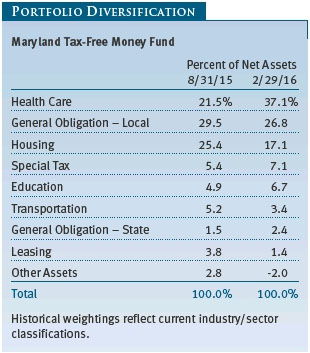
T. Rowe Price has been carefully considering these SEC rule changes and their implications and is crafting solutions designed to minimize the impact on our money fund shareholders. As such, we will introduce changes to our money fund lineup in 2016. While most modifications will have little effect on the majority of shareholders, some will be more noticeable, such as changes to some funds’ investment strategies or the suitability of a given fund for certain classes of investors.
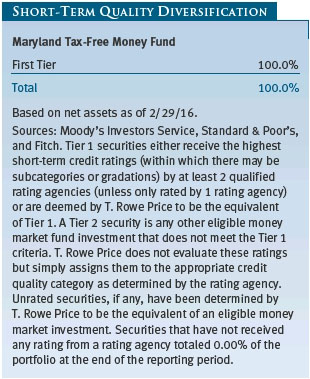
As for the Maryland Tax-Free Money Fund, we are not making any changes to the fund’s investment program. However, per the new SEC rules, the fund must adopt the ability—effective October 14, 2016—to implement liquidity fees or temporarily suspend redemptions (also known as “gates”) in times of severe redemption pressure on the fund. Also, because the fund will be available only to individual investors under the new rules, we will be closing the fund to new institutional accounts on July 1, 2016. Institutional investors who already have an account in the fund may continue to add to their account after July 1, 2016, but they will need to exchange into another fund or redeem their shares by September 23, 2016. We expect to provide more detailed information about these and other money fund rule-related changes within the coming months to help shareholders make informed decisions.
Maryland Short-Term Tax-Free Bond Fund
The Maryland Short-Term Tax-Free Bond Fund returned 0.86% for the 12-month period ended February 29, 2016, outperforming the Lipper Short Municipal Debt Funds Average of similarly managed funds. The fund benefited from its yield curve positioning as well as favorable sector allocations and security selection over the past year.
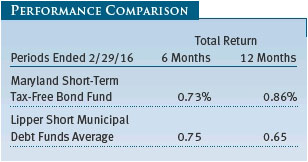
Our overweight to longer maturities, specifically the five-year segment of the yield curve, and underweight at the shorter end of the curve contributed to relative results. We shortened the portfolio’s weighted average maturity and duration slightly since our last letter six months ago, reaching our shortest positioning in the past two years, although we maintain a slightly longer duration than the benchmark. We made this move because we believed the market would react negatively to the rate hike in December, but the volatility in the equities markets, particularly in commodity-related sectors, alleviated concerns about further Fed rate hikes in the near term.
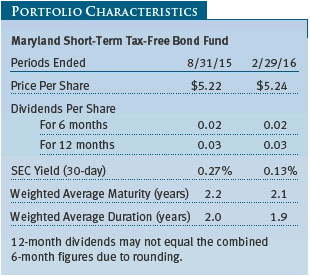
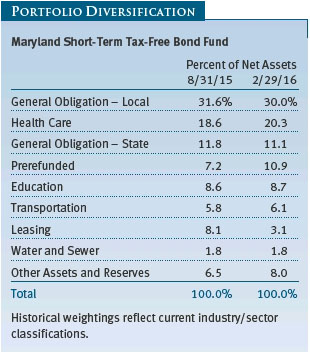
Our significant underweight to the prerefunded sector added value during the one-year period as the high-quality, lower-yielding sector underperformed both general obligation debt and revenue bonds. Our prerefunded holdings increased over the past 12 months from 3.9% to nearly 11% of the portfolio as low interest rates enabled issuers to refinance their higher-cost debt at more favorable terms. Our exposure in these high-quality securities provides a source of liquidity for the portfolio but remains well below that of our benchmark.
Over the fiscal year, we modestly reduced our positions in state and local general obligation bonds in favor of a number of health care issues available in both the secondary and new issue markets. Specifically, purchases included health care names such as Frederick Memorial Hospital, Anne Arundel Heath System, University of Maryland Medical System, and Meritus Medical Center. We also added a student housing bond from the University of Maryland. All of these revenue bond purchases provide excess yield over higher-quality general obligation and prerefunded bonds and increase the portfolio’s diversification. (Please refer to the fund’s portfolio of investments for a complete list of our holdings and the amount each represents in the portfolio.)

As shown in the Quality Diversification chart, investment-grade issues made up 98% of the portfolio at the end of the period. Given our limited opportunities to buy lower-rated, higher-yielding Maryland debt, the majority of the portfolio is allocated to AAA and AA rated bonds. However, over the past year, we have trimmed that allocation from 75% to 64% as we found attractive opportunities in the BBB rated category, which now stands at 17% of assets.
Maryland Tax-Free Bond Fund
The Maryland Tax-Free Bond Fund returned 3.53% in the 12 months ended February 29, 2016, outpacing its Lipper Maryland Municipal Debt Funds Average. The fund also outperformed for the most recent six-month period. The fund’s returns continued to benefit from our emphasis on revenue bonds, our sector mix, and our security selection.
Our overweight on the long end of the yield curve, a strategy that has endured more or less since the 2008 crisis, continued to pay dividends as the long end once again provided some of the best returns for the period.

Your fund continued to compare very favorably with its competitors over the long term. Lipper ranked the Maryland Tax-Free Bond Fund first among its peer group of Maryland municipal debt funds for the 3-, 5-, and 10-year periods ended February 29, 2016, and in the top quintile of the peer group for the past 12 months. (Based on cumulative total return, Lipper ranked the Maryland Tax-Free Bond Fund 4 of 31, 1 of 30, 1 of 29, and 1 of 20 funds for the 1-, 3-, 5-, and 10-year periods ended February 29, 2016, respectively. Past performance cannot guarantee future results.)
We entered the second half of our fiscal year with a conservative interest rate posture as we prepared for the Fed’s initial rate increase. While our overall view is for higher rates eventually, we moderated the defensive nature of our positioning as it became increasingly clear that the pace of Fed rate hikes in 2016 would be much slower than most had predicted. As such, our average maturity extended 0.2 years to 15.2 years over the past six months, and our duration extended slightly to 4.2 years.
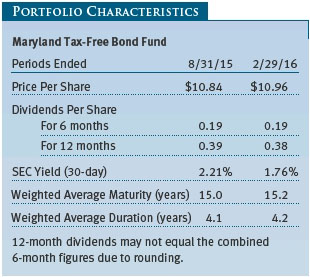
Because of our concerns about the willingness and ability of some municipalities to fund long-term liabilities such as pensions and health care coverage for retirees, we have generally kept our allocation to long-term general obligation bonds low. Nonetheless, we modestly increased our positions in GO debt over the past six months and added several highly rated bonds from jurisdictions where long-term liability issues are less of a concern. These purchases included securities from Baltimore County, Anne Arundel County, and the Washington Suburban Sanitary District, where debt service is paid from water and sewer charges but there is a backup pledge of property taxes from the underlying jurisdictions. (Please refer to the fund’s portfolio of investments for a complete list of our holdings and the amount each represents in the portfolio.)
Among the revenue sectors, our largest allocation is to health care, with our holdings focused on hospitals. Hospital bonds outperformed most other sectors in 2015, and many of our hospital holdings were among the fund’s top contributors. We increased our hospital and life care holdings during the period. Maryland has many well-run hospitals, and its unique reimbursement environment improves the risk/reward potential in this sector. Away from health care, our most significant investment during the past six months was for a student housing project at the University of Maryland. While the issue came with an additional insurance wrap, its yield was attractive enough to get our attention, and we believe this holding could provide excellent long-term returns for our portfolio.
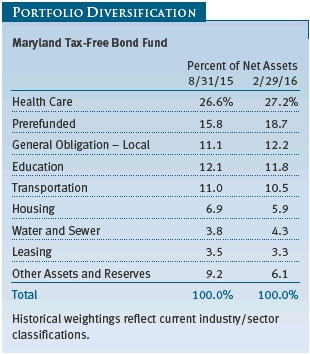
Our prerefunded allocation increased over the past year as issuers refinanced higher-cost debt at lower rates. However, the sector underperformed the broader municipal market because of the short maturity and high-quality nature of this type of security. Nonetheless, at 18.7% of the portfolio, this sector provides a good store of liquidity should attractive investment opportunities arise.
Regarding the portfolio’s quality, we favor A rated bonds for the yield premium these bonds generally offer, and we also maintain an overweight in BBB securities. This positioning served the portfolio well over the reporting period as lower-quality bonds outperformed their higher-quality counterparts. As always, we will continue to focus on generating tax-free income and the best long-term prospects for Marylanders, led by T. Rowe Price’s strong research capabilities and our fundamentals-driven investment process.
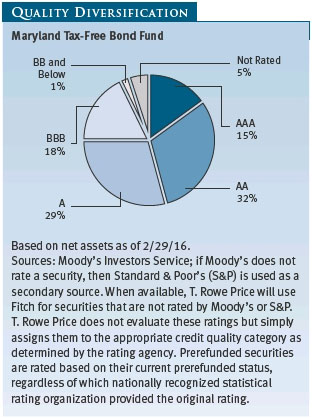
OUTLOOK
We believe that the municipal bond market remains a high-quality market that offers good opportunities for long-term investors seeking tax-free income. While fundamentals are sound overall and technical support should persist, investors should expect modest returns in 2016, perhaps just earning the coupon income offset somewhat by modest declines in principal values. If the economic recovery prompts the Fed to continue raising short-term interest rates, muni bond yields are likely to rise along with Treasury yields—although not to the same extent. While higher yields typically pressure bond prices, we expect Fed rate increases to be gradual and modest. Moreover, munis should be less susceptible to rising rates than Treasuries given their attractive tax-equivalent yields and the steady demand for tax-exempt income.
While we believe that many states deserve high credit ratings and will be able to continue servicing their debts, we have longer-term concerns about significant funding shortfalls for pensions and OPEB obligations in some jurisdictions. These funding gaps stem from investment losses during the financial crisis, insufficient plan contributions over time, and unrealistic return projections. Although few large plans are at risk of insolvency in the near term, the magnitude of unfunded liabilities is becoming more conspicuous in a few states.
Ultimately, we believe T. Rowe Price’s independent credit research is our greatest strength and will remain an asset for our investors as we navigate the current market environment. As always, we focus on finding attractively valued bonds issued by municipalities with good long-term fundamentals—an investment strategy that we believe will continue to serve our investors well.
Thank you for investing with T. Rowe Price.
Respectfully submitted,

Joseph K. Lynagh
Chairman of the Investment Advisory Committee
Maryland Tax-Free Money Fund

Charles B. Hill
Chairman of the Investment Advisory Committee
Maryland Short-Term Tax-Free Bond Fund

Hugh D. McGuirk
Chairman of the Investment Advisory Committee
Maryland Tax-Free Bond Fund
March 21, 2016
The committee chairmen have day-to-day responsibility for managing the portfolios and work with committee members in developing and executing the funds’ investment programs.
RISKS OF INVESTING
Since money market funds are managed to maintain a constant $1.00 share price, they should have little risk of principal loss. However, there is no assurance the fund will avoid principal losses if fund holdings default or are downgraded or interest rates rise sharply in an unusually short period. In addition, the fund’s yield will vary; it is not fixed for a specific period like the yield on a bank certificate of deposit. An investment in the fund is not insured or guaranteed by the Federal Deposit Insurance Corporation (FDIC) or any other government agency. Although a money market fund seeks to preserve the value of your investment at $1.00 per share, it is possible to lose money by investing in it. The fund’s sponsor has no legal obligation to provide financial support to the fund, and you should not expect that the sponsor will provide financial support to the fund at any time.
Bonds are subject to interest rate risk (the decline in bond prices that usually accompanies a rise in interest rates) and credit risk (the chance that any fund holding could have its credit rating downgraded or that a bond issuer will default by failing to make timely payments of interest or principal), potentially reducing the fund’s income level and share price. The Maryland Tax-Free Funds are less diversified than those investing nationally. Some income may be subject to state and local taxes and the federal alternative minimum tax.
GLOSSARY
Barclays Municipal Bond Index: A broadly diversified index of tax-exempt bonds.
Basis point: One one-hundredth of one percentage point, or 0.01%.
Duration: A measure of a bond fund’s sensitivity to changes in interest rates. For example, a fund with a duration of five years would fall about 5% in price in response to a one-percentage-point rise in interest rates, and vice versa.
Federal funds rate (or target rate): The interest rate charged on overnight loans of reserves by one financial institution to another in the United States. The Federal Reserve sets a target federal funds rate to affect the direction of interest rates.
General obligation (GO) debt: A government’s strongest pledge that obligates its full faith and credit, including, if necessary, its ability to raise taxes.
Lipper averages: The averages of available mutual fund performance returns for specified time periods in categories defined by Lipper Inc.
Lipper indexes: Fund benchmarks that consist of a small number (10 to 30) of the largest mutual funds in a particular category as tracked by Lipper Inc.
Other post-employment benefits (OPEB): Benefits paid to an employee after retirement, such as premiums for life and health insurance.
Prerefunded bond: A bond that originally may have been issued as a general obligation or revenue bond but that is now secured by an escrow fund consisting entirely of direct U.S. government obligations that are sufficient for paying the bondholders.
Revenue (or revenue-backed) bond: A bond issued to fund specific projects, such as airports, bridges, hospitals, or toll roads, where a portion of the revenue generated is used to service the interest payments on the bonds.
SEC yield (30-day): A method of calculating a fund’s yield that assumes all portfolio securities are held until maturity. Yield will vary and is not guaranteed.
Variable rate demand note (VRDN): Generally, a debt security that requires the issuer to redeem at the holder’s discretion on a specified date or dates prior to maturity. Upon redemption, the issuer pays par to the holder who loses future coupon payments that might otherwise be due. The VRDN might be especially attractive at times of rising rates, to protect against interest rate risk by redeeming at par value, and reinvesting proceeds in a new bond.
Weighted average life: A measure of a fund’s credit quality risk. In general, the longer the average life, the greater the fund’s credit quality risk. The average life is the dollar-weighted average maturity of a portfolio’s individual securities without taking into account interest rate readjustment dates. Money funds must maintain a weighted average life of less than 120 days.
Weighted average maturity: A measure of a fund’s interest rate sensitivity. In general, the longer the average maturity, the greater the fund’s sensitivity to interest rate changes. The weighted average maturity may take into account the interest rate readjustment dates for certain securities. Money funds must maintain a weighted average maturity of less than 60 days.
Yield curve: A graph depicting the relationship between yields and maturity dates for a set of similar securities. A security with a longer maturity usually has a higher yield. If a short-term security offers a higher yield, then the curve is said to be “inverted.” If short- and long-term bonds are offering equivalent yields, then the curve is said to be “flat.”
Performance and Expenses
This chart shows the value of a hypothetical $10,000 investment in the fund over the past 10 fiscal year periods or since inception (for funds lacking 10-year records). The result is compared with benchmarks, which may include a broad-based market index and a peer group average or index. Market indexes do not include expenses, which are deducted from fund returns as well as mutual fund averages and indexes.
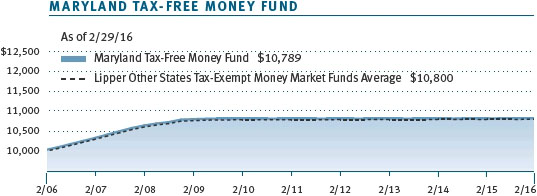

This chart shows the value of a hypothetical $10,000 investment in the fund over the past 10 fiscal year periods or since inception (for funds lacking 10-year records). The result is compared with benchmarks, which may include a broad-based market index and a peer group average or index. Market indexes do not include expenses, which are deducted from fund returns as well as mutual fund averages and indexes.
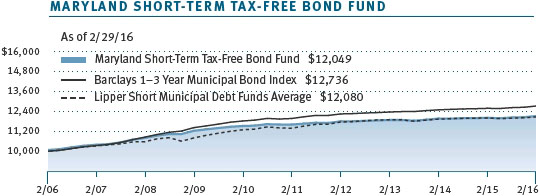
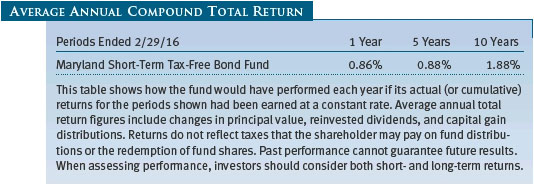
This chart shows the value of a hypothetical $10,000 investment in the fund over the past 10 fiscal year periods or since inception (for funds lacking 10-year records). The result is compared with benchmarks, which may include a broad-based market index and a peer group average or index. Market indexes do not include expenses, which are deducted from fund returns as well as mutual fund averages and indexes.
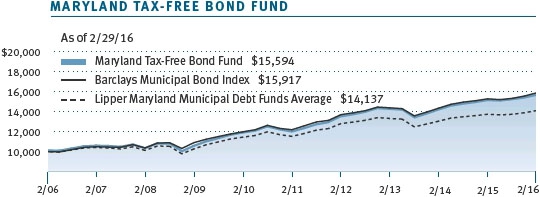

As a mutual fund shareholder, you may incur two types of costs: (1) transaction costs, such as redemption fees or sales loads, and (2) ongoing costs, including management fees, distribution and service (12b-1) fees, and other fund expenses. The following example is intended to help you understand your ongoing costs (in dollars) of investing in the fund and to compare these costs with the ongoing costs of investing in other mutual funds. The example is based on an investment of $1,000 invested at the beginning of the most recent six-month period and held for the entire period.
Actual Expenses
The first line of the following table (Actual) provides information about actual account values and expenses based on the fund’s actual returns. You may use the information on this line, together with your account balance, to estimate the expenses that you paid over the period. Simply divide your account value by $1,000 (for example, an $8,600 account value divided by $1,000 = 8.6), then multiply the result by the number on the first line under the heading “Expenses Paid During Period” to estimate the expenses you paid on your account during this period.
Hypothetical Example for Comparison Purposes
The information on the second line of the table (Hypothetical) is based on hypothetical account values and expenses derived from the fund’s actual expense ratio and an assumed 5% per year rate of return before expenses (not the fund’s actual return). You may compare the ongoing costs of investing in the fund with other funds by contrasting this 5% hypothetical example and the 5% hypothetical examples that appear in the shareholder reports of the other funds. The hypothetical account values and expenses may not be used to estimate the actual ending account balance or expenses you paid for the period.
Note: T. Rowe Price charges an annual account service fee of $20, generally for accounts with less than $10,000. The fee is waived for any investor whose T. Rowe Price mutual fund accounts total $50,000 or more; accounts electing to receive electronic delivery of account statements, transaction confirmations, prospectuses, and shareholder reports; or accounts of an investor who is a T. Rowe Price Preferred Services, Personal Services, or Enhanced Personal Services client (enrollment in these programs generally requires T. Rowe Price assets of at least $100,000). This fee is not included in the accompanying table. If you are subject to the fee, keep it in mind when you are estimating the ongoing expenses of investing in the fund and when comparing the expenses of this fund with other funds.
You should also be aware that the expenses shown in the table highlight only your ongoing costs and do not reflect any transaction costs, such as redemption fees or sales loads. Therefore, the second line of the table is useful in comparing ongoing costs only and will not help you determine the relative total costs of owning different funds. To the extent a fund charges transaction costs, however, the total cost of owning that fund is higher.

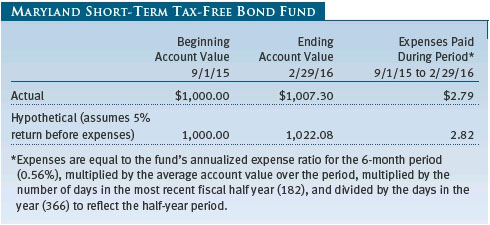
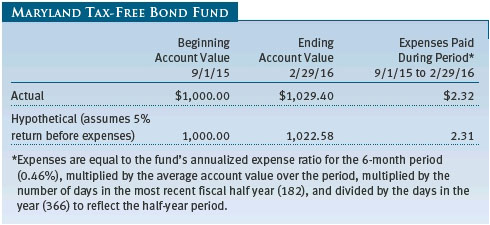
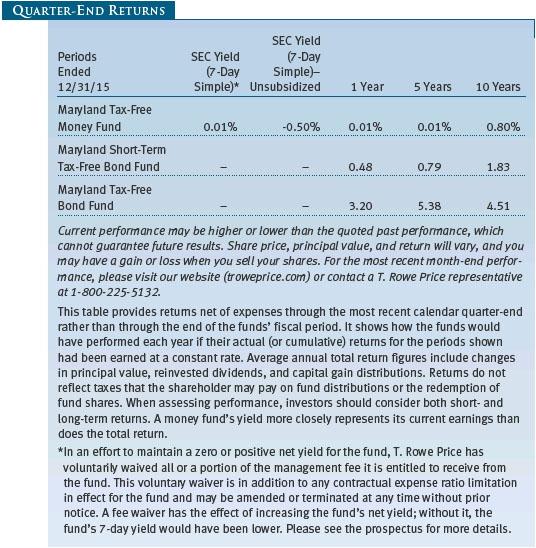

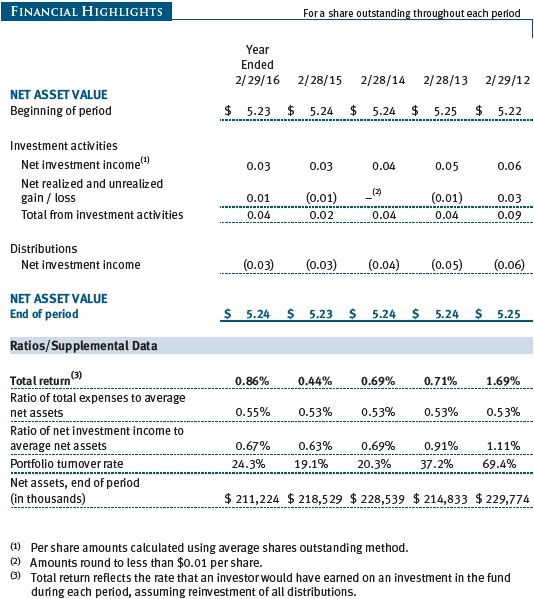
The accompanying notes are an integral part of these financial statements.

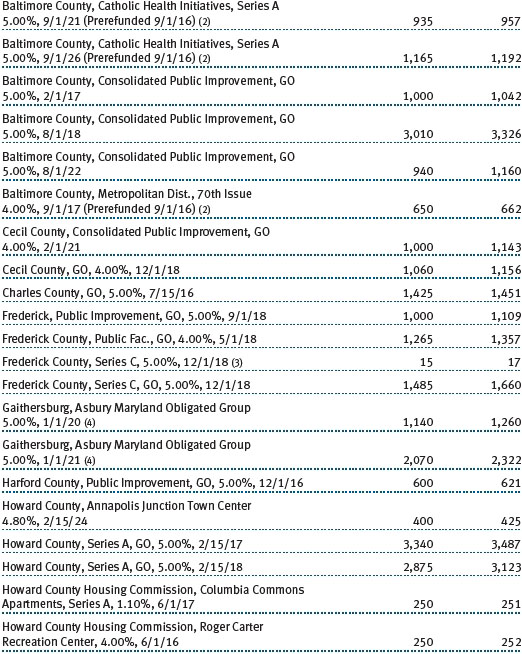
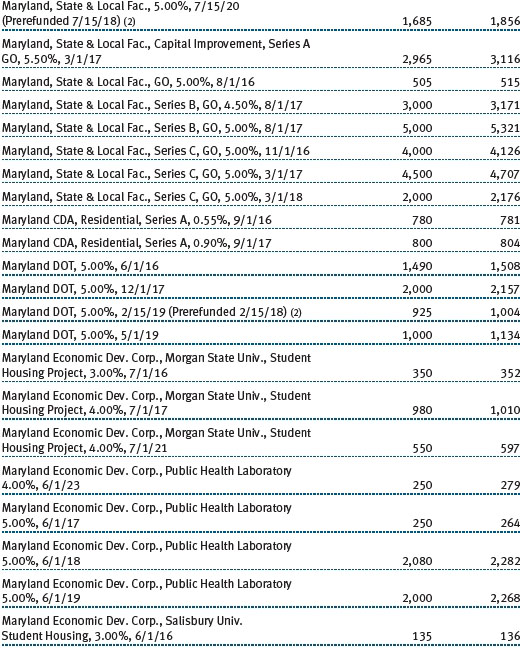
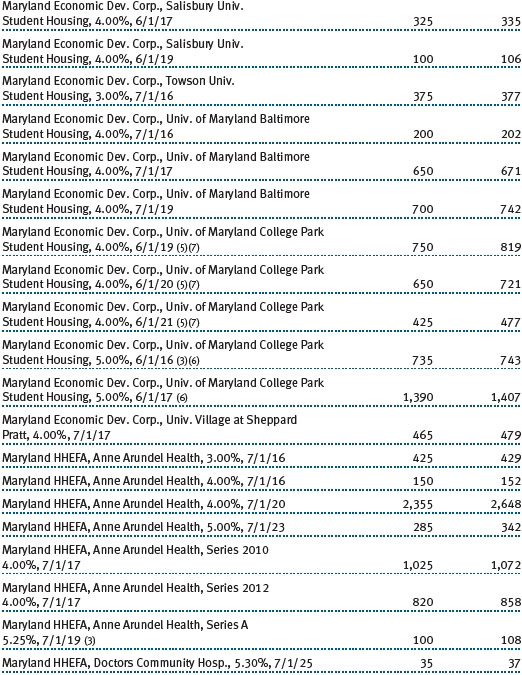
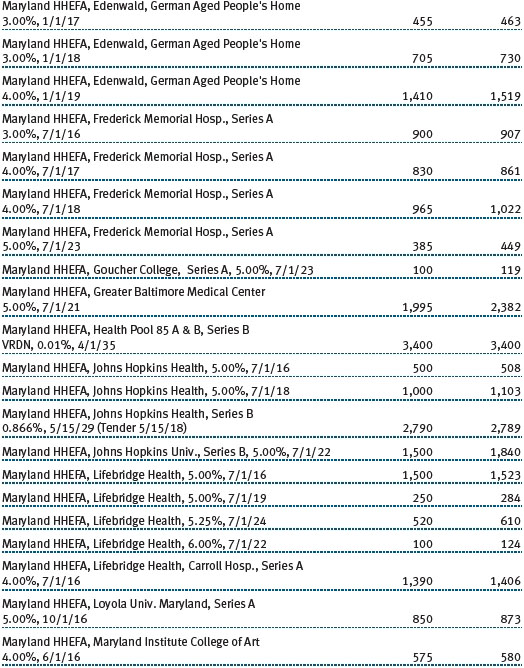
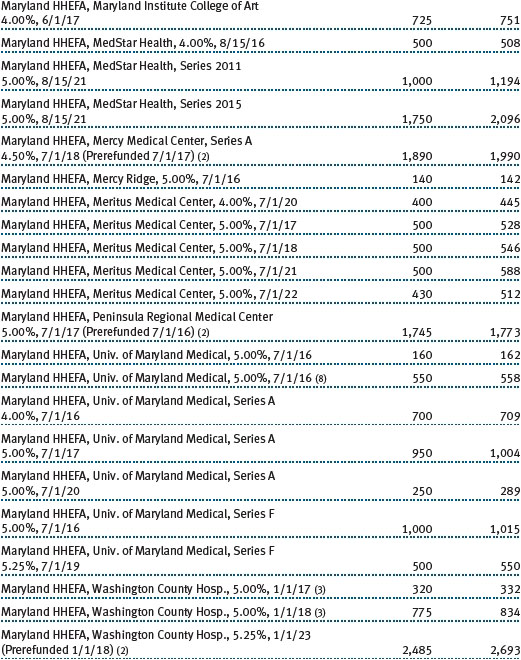

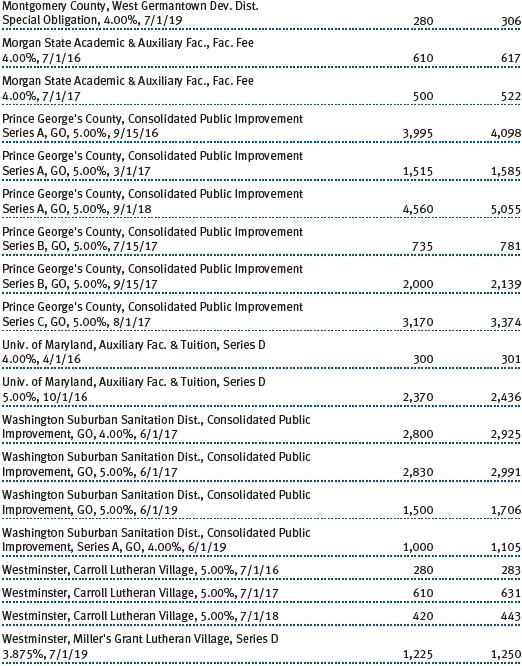
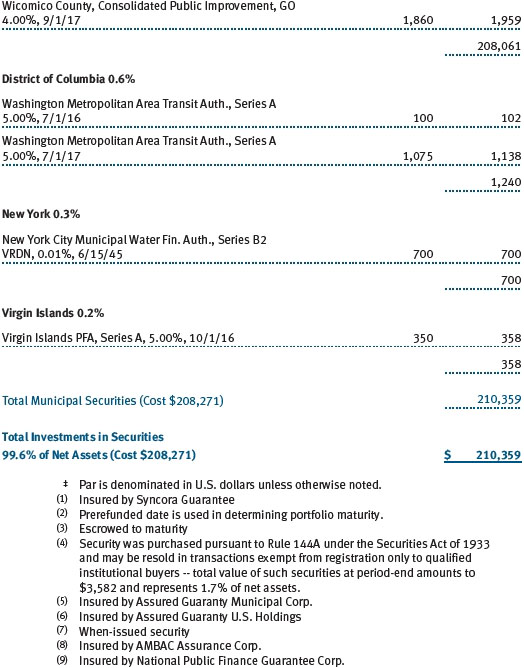
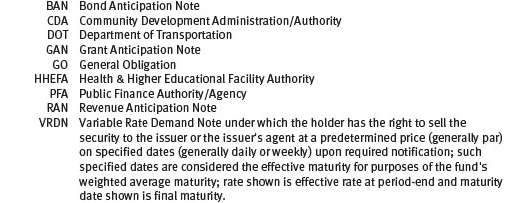
The accompanying notes are an integral part of these financial statements.
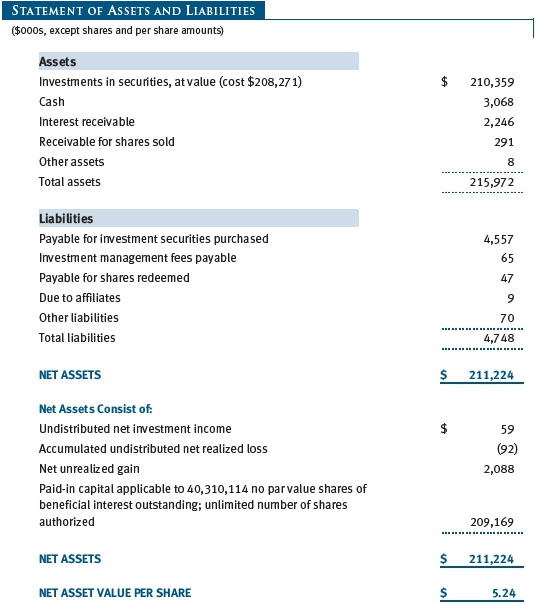
The accompanying notes are an integral part of these financial statements.
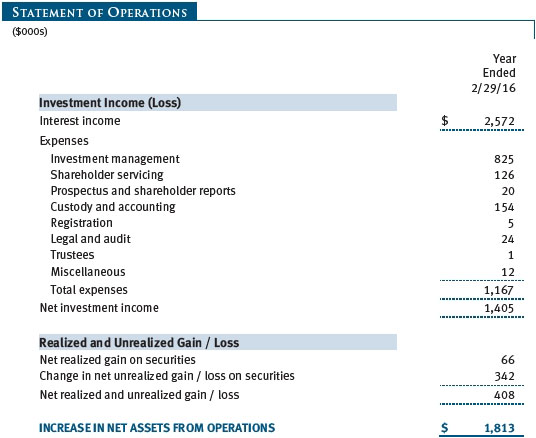
The accompanying notes are an integral part of these financial statements.
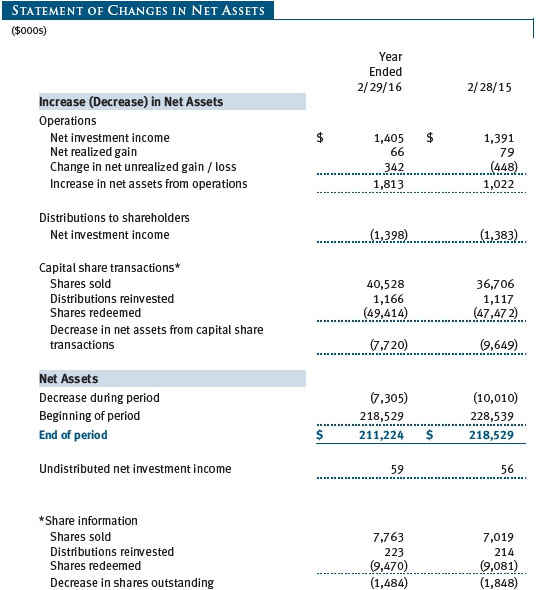
The accompanying notes are an integral part of these financial statements.
| Notes to Financial Statements |
T. Rowe Price State Tax-Free Income Trust (the trust), is registered under the Investment Company Act of 1940 (the 1940 Act). The Maryland Short-Term Tax-Free Bond Fund (the fund) is a nondiversified, open-end management investment company established by the trust. The fund commenced operations on January 29, 1993. The fund seeks to provide the highest level of income exempt from federal and Maryland state and local income taxes consistent with modest fluctuation in principal value.
NOTE 1 - SIGNIFICANT ACCOUNTING POLICIES
Basis of Preparation The fund is an investment company and follows accounting and reporting guidance in the Financial Accounting Standards Board (FASB) Accounting Standards Codification Topic 946 (ASC 946). The accompanying financial statements were prepared in accordance with accounting principles generally accepted in the United States of America (GAAP), including, but not limited to, ASC 946. GAAP requires the use of estimates made by management. Management believes that estimates and valuations are appropriate; however, actual results may differ from those estimates, and the valuations reflected in the accompanying financial statements may differ from the value ultimately realized upon sale or maturity.
Investment Transactions, Investment Income, and Distributions Income and expenses are recorded on the accrual basis. Premiums and discounts on debt securities are amortized for financial reporting purposes. Income tax-related interest and penalties, if incurred, would be recorded as income tax expense. Investment transactions are accounted for on the trade date. Realized gains and losses are reported on the identified cost basis. Income distributions are declared daily and paid monthly. Distributions to shareholders are recorded on the ex-dividend date. Capital gain distributions, if any, are generally declared and paid by the fund annually.
New Accounting Guidance In May 2015, FASB issued ASU No. 2015-07, Fair Value Measurement (Topic 820), Disclosures for Investments in Certain Entities That Calculate Net Asset Value per Share (or Its Equivalent). The ASU removes the requirement to categorize within the fair value hierarchy all investments for which fair value is measured using the net asset value per share practical expedient and amends certain disclosure requirements for such investments.
The ASU is effective for interim and annual reporting periods beginning after December 15, 2015. Adoption will have no effect on the fund’s net assets or results of operations.
NOTE 2 - VALUATION
The fund’s financial instruments are valued and its net asset value (NAV) per share is computed at the close of the New York Stock Exchange (NYSE), normally 4 p.m. ET, each day the NYSE is open for business.
Fair Value The fund’s financial instruments are reported at fair value, which GAAP defines as the price that would be received to sell an asset or paid to transfer a liability in an orderly transaction between market participants at the measurement date. The T. Rowe Price Valuation Committee (the Valuation Committee) has been established by the fund’s Board of Trustees (the Board) to ensure that financial instruments are appropriately priced at fair value in accordance with GAAP and the 1940 Act. Subject to oversight by the Board, the Valuation Committee develops and oversees pricing-related policies and procedures and approves all fair value determinations. Specifically, the Valuation Committee establishes procedures to value securities; determines pricing techniques, sources, and persons eligible to effect fair value pricing actions; oversees the selection, services, and performance of pricing vendors; oversees valuation-related business continuity practices; and provides guidance on internal controls and valuation-related matters. The Valuation Committee reports to the Board and has representation from legal, portfolio management and trading, operations, risk management, and the fund’s treasurer.
Various valuation techniques and inputs are used to determine the fair value of financial instruments. GAAP establishes the following fair value hierarchy that categorizes the inputs used to measure fair value:
Level 1 – quoted prices (unadjusted) in active markets for identical financial instruments that the fund can access at the reporting date
Level 2 – inputs other than Level 1 quoted prices that are observable, either directly or indirectly (including, but not limited to, quoted prices for similar financial instruments in active markets, quoted prices for identical or similar financial instruments in inactive markets, interest rates and yield curves, implied volatilities, and credit spreads)
Level 3 – unobservable inputs
Observable inputs are developed using market data, such as publicly available information about actual events or transactions, and reflect the assumptions that market participants would use to price the financial instrument. Unobservable inputs are those for which market data are not available and are developed using the best information available about the assumptions that market participants would use to price the financial instrument. GAAP requires valuation techniques to maximize the use of relevant observable inputs and minimize the use of unobservable inputs. When multiple inputs are used to derive fair value, the financial instrument is assigned to the level within the fair value hierarchy based on the lowest-level input that is significant to the fair value of the financial instrument. Input levels are not necessarily an indication of the risk or liquidity associated with financial instruments at that level but rather the degree of judgment used in determining those values.
Valuation Techniques Debt securities generally are traded in the over-the-counter (OTC) market. Securities with remaining maturities of one year or more at the time of acquisition are valued at prices furnished by dealers who make markets in such securities or by an independent pricing service, which considers the yield or price of bonds of comparable quality, coupon, maturity, and type, as well as prices quoted by dealers who make markets in such securities. Securities with remaining maturities of less than one year at the time of acquisition generally use amortized cost in local currency to approximate fair value. However, if amortized cost is deemed not to reflect fair value or the fund holds a significant amount of such securities with remaining maturities of more than 60 days, the securities are valued at prices furnished by dealers who make markets in such securities or by an independent pricing service. Generally, debt securities are categorized in Level 2 of the fair value hierarchy; however, to the extent the valuations include significant unobservable inputs, the securities would be categorized in Level 3.
Assets and liabilities other than financial instruments, including short-term receivables and payables, are carried at cost, or estimated realizable value, if less, which approximates fair value.
Thinly traded financial instruments and those for which the above valuation procedures are inappropriate or are deemed not to reflect fair value are stated at fair value as determined in good faith by the Valuation Committee. The objective of any fair value pricing determination is to arrive at a price that could reasonably be expected from a current sale. Financial instruments fair valued by the Valuation Committee are primarily private placements, restricted securities, warrants, rights, and other securities that are not publicly traded.
Subject to oversight by the Board, the Valuation Committee regularly makes good faith judgments to establish and adjust the fair valuations of certain securities as events occur and circumstances warrant. For instance, in determining the fair value of troubled or thinly traded debt instruments, the Valuation Committee considers a variety of factors, which may include, but are not limited to, the issuer’s business prospects, its financial standing and performance, recent investment transactions in the issuer, strategic events affecting the company, market liquidity for the issuer, and general economic conditions and events. In consultation with the investment and pricing teams, the Valuation Committee will determine an appropriate valuation technique based on available information, which may include both observable and unobservable inputs. The Valuation Committee typically will afford greatest weight to actual prices in arm’s length transactions, to the extent they represent orderly transactions between market participants, transaction information can be reliably obtained, and prices are deemed representative of fair value. However, the Valuation Committee may also consider other valuation methods such as a discount or premium from market value of a similar, freely traded security of the same issuer; discounted cash flows; yield to maturity; or some combination. Fair value determinations are reviewed on a regular basis and updated as information becomes available, including actual purchase and sale transactions of the issue. Because any fair value determination involves a significant amount of judgment, there is a degree of subjectivity inherent in such pricing decisions, and fair value prices determined by the Valuation Committee could differ from those of other market participants. Depending on the relative significance of unobservable inputs, including the valuation technique(s) used, fair valued securities may be categorized in Level 2 or 3 of the fair value hierarchy.
Valuation Inputs On February 29, 2016, all of the fund’s financial instruments were classified as Level 2, based on the inputs used to determine their fair values. There were no material transfers between Levels 1 and 2 during the year ended February 29, 2016.
NOTE 3 - OTHER INVESTMENT TRANSACTIONS
Consistent with its investment objective, the fund engages in the following practices to manage exposure to certain risks and/or to enhance performance. The investment objective, policies, program, and risk factors of the fund are described more fully in the fund’s prospectus and Statement of Additional Information.
Restricted Securities The fund may invest in securities that are subject to legal or contractual restrictions on resale. Prompt sale of such securities at an acceptable price may be difficult and may involve substantial delays and additional costs.
When-Issued Securities The fund may enter into when-issued purchase or sale commitments, pursuant to which it agrees to purchase or sell, respectively, an authorized but not yet issued security for a fixed unit price, with payment and delivery not due until issuance of the security on a scheduled future date. When-issued securities may be new securities or securities issued through a corporate action, such as a reorganization or restructuring. Until settlement, the fund maintains liquid assets sufficient to settle its commitment to purchase a when-issued security or, in the case of a sale commitment, the fund maintains an entitlement to the security to be sold. Amounts realized on when-issued transactions are included in realized gain/loss on securities in the accompanying financial statements.
Other Purchases and sales of portfolio securities other than short-term securities aggregated $49,791,000 and $56,864,000, respectively, for the year ended February 29, 2016.
NOTE 4 - FEDERAL INCOME TAXES
No provision for federal income taxes is required since the fund intends to continue to qualify as a regulated investment company under Subchapter M of the Internal Revenue Code and distribute to shareholders all of its income and gains. Distributions determined in accordance with federal income tax regulations may differ in amount or character from net investment income and realized gains for financial reporting purposes. Financial reporting records are adjusted for permanent book/tax differences to reflect tax character but are not adjusted for temporary differences.
The fund files U.S. federal, state, and local tax returns as required. The fund’s tax returns are subject to examination by the relevant tax authorities until expiration of the applicable statute of limitations, which is generally three years after the filing of the tax return but which can be extended to six years in certain circumstances. Tax returns for open years have incorporated no uncertain tax positions that require a provision for income taxes.
Reclassifications to paid-in capital relate primarily to expiring capital loss carryforwards. For the year ended February 29, 2016, the following reclassifications were recorded to reflect tax character (there was no impact on results of operations or net assets):

Distributions during the years ended February 29, 2016 and February 28, 2015, totaled $1,398,000 and $1,383,000, respectively, and were characterized as tax-exempt income for tax purposes. At February 29, 2016, the tax-basis cost of investments and components of net assets were as follows:
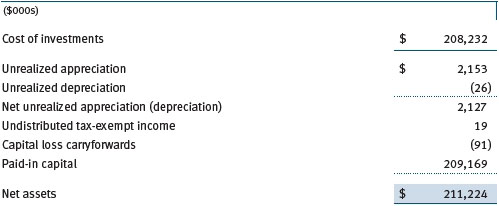
The fund intends to retain realized gains to the extent of available capital loss carryforwards. Because the fund is required to use capital loss carryforwards that do not expire before those with expiration dates, all or a portion of its capital loss carryforwards subject to expiration could ultimately go unused. During the year ended February 29, 2016, the fund utilized $67,000 of capital loss carryforwards. The fund’s available capital loss carryforwards as of February 29, 2016, expire as follows: $75,000 in fiscal 2018 and $16,000 in fiscal 2019.
NOTE 5 - RELATED PARTY TRANSACTIONS
The fund is managed by T. Rowe Price Associates, Inc. (Price Associates), a wholly owned subsidiary of T. Rowe Price Group, Inc. (Price Group). The investment management agreement between the fund and Price Associates provides for an annual investment management fee, which is computed daily and paid monthly. The fee consists of an individual fund fee, equal to 0.10% of the fund’s average daily net assets, and a group fee. The group fee rate is calculated based on the combined net assets of certain mutual funds sponsored by Price Associates (the group) applied to a graduated fee schedule, with rates ranging from 0.48% for the first $1 billion of assets to 0.275% for assets in excess of $400 billion. The fund’s group fee is determined by applying the group fee rate to the fund’s average daily net assets. At February 29, 2016, the effective annual group fee rate was 0.29%.
In addition, the fund has entered into service agreements with Price Associates and a wholly owned subsidiary of Price Associates (collectively, Price). Price Associates provides certain accounting and administrative services to the fund. T. Rowe Price Services, Inc., provides shareholder and administrative services in its capacity as the fund’s transfer and dividend-disbursing agent. For the year ended February 29, 2016, expenses incurred pursuant to these service agreements were $70,000 for Price Associates; and $56,000 for T. Rowe Price Services, Inc. The total amount payable at period-end pursuant to these service agreements is reflected as Due to Affiliates in the accompanying financial statements.
The fund may participate in securities purchase and sale transactions with other funds or accounts advised by Price Associates (cross trades), in accordance with procedures adopted by the fund’s Board and Securities and Exchange Commission rules, which require, among other things, that such purchase and sale cross trades be effected at the independent current market price of the security. Purchases and sales cross trades aggregated $20,870,000 and $16,870,000, respectively, with net realized gain of $0 for the year ended February 29, 2016. Generally, cross trades were executed due to the limited supply of high-quality municipal securities available in the market and the adviser’s decision to continue owning certain investments in funds or accounts advised by Price Associates.
| Report of Independent Registered Public Accounting Firm |
To the Board of Trustees of T. Rowe Price State Tax-Free Income Trust and
Shareholders of Maryland Short-Term Tax-Free Bond Fund
In our opinion, the accompanying statement of assets and liabilities, including the portfolio of investments, and the related statements of operations and of changes in net assets and the financial highlights present fairly, in all material respects, the financial position of the Maryland Short-Term Tax-Free Bond Fund (one of the portfolios comprising T. Rowe Price State Tax-Free Income Trust, hereafter referred to as the “Fund”) at February 29, 2016, the results of its operations, the changes in its net assets and the financial highlights for each of the periods indicated therein, in conformity with accounting principles generally accepted in the United States of America. These financial statements and financial highlights (hereafter referred to as “financial statements”) are the responsibility of the Fund’s management. Our responsibility is to express an opinion on these financial statements based on our audits. We conducted our audits of these financial statements in accordance with the standards of the Public Company Accounting Oversight Board (United States). Those standards require that we plan and perform the audit to obtain reasonable assurance about whether the financial statements are free of material misstatement. An audit includes examining, on a test basis, evidence supporting the amounts and disclosures in the financial statements, assessing the accounting principles used and significant estimates made by management, and evaluating the overall financial statement presentation. We believe that our audits, which included confirmation of securities at February 29, 2016 by correspondence with the custodian and brokers, provide a reasonable basis for our opinion.
PricewaterhouseCoopers LLP
Baltimore, Maryland
April 20, 2016
| Tax Information (Unaudited) for the Tax Year Ended 2/29/16 |
We are providing this information as required by the Internal Revenue Code. The amounts shown may differ from those elsewhere in this report because of differences between tax and financial reporting requirements.
The fund’s distributions to shareholders included:
| ● | $4,000 from short-term capital gains |
| |
| ● | $1,417,000 which qualified as exempt-interest dividends. |
| Information on Proxy Voting Policies, Procedures, and Records |
A description of the policies and procedures used by T. Rowe Price funds and portfolios to determine how to vote proxies relating to portfolio securities is available in each fund’s Statement of Additional Information. You may request this document by calling 1-800-225-5132 or by accessing the SEC’s website, sec.gov.
The description of our proxy voting policies and procedures is also available on our website, troweprice.com. To access it, click on the words “Social Responsibility” at the top of our corporate homepage. Next, click on the words “Conducting Business Responsibly” on the left side of the page that appears. Finally, click on the words “Proxy Voting Policies” on the left side of the page that appears.
Each fund’s most recent annual proxy voting record is available on our website and through the SEC’s website. To access it through our website, follow the above directions to reach the “Conducting Business Responsibly” page. Click on the words “Proxy Voting Records” on the left side of that page, and then click on the “View Proxy Voting Records” link at the bottom of the page that appears.
| How to Obtain Quarterly Portfolio Holdings |
The fund files a complete schedule of portfolio holdings with the Securities and Exchange Commission for the first and third quarters of each fiscal year on Form N-Q. The fund’s Form N-Q is available electronically on the SEC’s website (sec.gov); hard copies may be reviewed and copied at the SEC’s Public Reference Room, 100 F St. N.E., Washington, DC 20549. For more information on the Public Reference Room, call 1-800-SEC-0330.
| About the Fund’s Trustees and Officers |
Your fund is overseen by a Board of Trustees (Board) that meets regularly to review a wide variety of matters affecting or potentially affecting the fund, including performance, investment programs, compliance matters, advisory fees and expenses, service providers, and business and regulatory affairs. The Board elects the fund’s officers, who are listed in the final table. At least 75% of the Board’s members are independent of T. Rowe Price Associates, Inc. (T. Rowe Price), and its affiliates; “inside” or “interested” trustees are employees or officers of T. Rowe Price. The business address of each trustee and officer is 100 East Pratt Street, Baltimore, Maryland 21202. The Statement of Additional Information includes additional information about the fund trustees and is available without charge by calling a T. Rowe Price representative at 1-800-638-5660.
| Independent Trustees | | |
| | | |
| Name | | |
| (Year of Birth) | | |
| Year Elected* | | |
| [Number of T. Rowe Price | | Principal Occupation(s) and Directorships of Public Companies and |
| Portfolios Overseen] | | Other Investment Companies During the Past Five Years |
| | | |
| William R. Brody, M.D., Ph.D. | | President and Trustee, Salk Institute for Biological Studies (2009 |
| (1944) | | to present); Director, BioMed Realty Trust (2013 to 2016); Director, |
| 2009 | | Novartis, Inc. (2009 to 2014); Director, IBM (2007 to present) |
| [184] | | |
| | | |
| Anthony W. Deering | | Chairman, Exeter Capital, LLC, a private investment firm (2004 to |
| (1945) | | present); Director, Brixmor Real Estate Investment Trust (2012 to |
| 1986 | | present); Director and Advisory Board Member, Deutsche Bank North |
| [184] | | America (2004 to present); Director, Under Armour (2008 to present); |
| | Director, Vornado Real Estate Investment Trust (2004 to 2012) |
| | | |
| Bruce W. Duncan | | President, Chief Executive Officer, and Director (2009 to present), |
| (1951) | | and Chairman of the Board (January 2016 to present), First Industrial |
| 2013 | | Realty Trust, an owner and operator of industrial properties; |
| [184] | | Chairman of the Board (2005 to present) and Director (1999 to |
| | present), Starwood Hotels & Resorts, a hotel and leisure company |
| | | |
| Robert J. Gerrard, Jr. | | Advisory Board Member, Pipeline Crisis/Winning Strategies, a |
| (1952) | | collaborative working to improve opportunities for young African |
| 2013 | | Americans (1997 to present) |
| [184] | | |
| | | |
| Paul F. McBride | | Advisory Board Member, Vizzia Technologies (2015 to present) |
| (1956) | | |
| 2013 | | |
| [184] | | |
| | | |
| Cecilia E. Rouse, Ph.D. | | Dean, Woodrow Wilson School (2012 to present); Professor and |
| (1963) | | Researcher, Princeton University (1992 to present); Director, MDRC, |
| 2013 | | a nonprofit education and social policy research organization (2011 |
| [184] | | to present); Member of National Academy of Education (2010 to |
| | present); Research Associate of Labor Program (2011 to present) |
| | and Board Member (2015 to present), National Bureau of Economic |
| | Research (2011 to present); Chair of Committee on the Status of |
| | Minority Groups in the Economic Profession (2012 to present) and |
| | Vice President (2015 to present), American Economic Association |
| | | |
| John G. Schreiber | | Owner/President, Centaur Capital Partners, Inc., a real estate |
| (1946) | | investment company (1991 to present); Cofounder, Partner, and |
| 1992 | | Cochairman of the Investment Committee, Blackstone Real Estate |
| [184] | | Advisors, L.P. (1992 to 2015); Director, General Growth Properties, |
| | Inc. (2010 to 2013); Director, Blackstone Mortgage Trust, a real |
| | estate financial company (2012 to 2016); Director and Chairman of |
| | the Board, Brixmor Property Group, Inc. (2013 to present); Director, |
| | Hilton Worldwide (2013 to present); Director, Hudson Pacific |
| | Properties (2014 to 2016) |
| | | |
| Mark R. Tercek | | President and Chief Executive Officer, The Nature Conservancy (2008 |
| (1957) | | to present) |
| 2009 | | |
| [184] | | |
| |
| *Each independent trustee serves until retirement, resignation, or election of a successor. |
| Inside Trustees | | |
| |
| Name | | |
| (Year of Birth) | | |
| Year Elected* | | |
| [Number of T. Rowe Price | | Principal Occupation(s) and Directorships of Public Companies and |
| Portfolios Overseen] | | Other Investment Companies During the Past Five Years |
| | | |
| Edward C. Bernard | | Director and Vice President, T. Rowe Price; Vice Chairman of the |
| (1956) | | Board, Director, and Vice President, T. Rowe Price Group, Inc.; |
| 2006 | | Chairman of the Board, Director, and President, T. Rowe Price |
| [184] | | Investment Services, Inc.; Chairman of the Board and Director, |
| | T. Rowe Price Retirement Plan Services, Inc., and T. Rowe Price |
| | Services, Inc.; Chairman of the Board, Chief Executive Officer, |
| | Director, and President, T. Rowe Price International and T. Rowe |
| | Price Trust Company; Chairman of the Board, all funds |
| | | |
| Edward A. Wiese, CFA | | Vice President, T. Rowe Price, T. Rowe Price Group, Inc., T. Rowe |
| (1959) | | Price International, and T. Rowe Price Trust Company; Vice President, |
| 2015 | | State Tax-Free Income Trust |
| [54] | | |
| |
| *Each inside trustee serves until retirement, resignation, or election of a successor. |
| Officers | | |
| |
| Name (Year of Birth) | | |
| Position Held With State Tax-Free Income Trust | | Principal Occupation(s) |
| | | |
| Austin Applegate (1974) | | Vice President, T. Rowe Price and T. Rowe Price |
| Vice President | | Group, Inc.; formerly, Senior Municipal Credit |
| | Research Analyst, Barclays (to 2011) |
| | | |
| R. Lee Arnold, Jr., CFA, CPA (1970) | | Vice President, T. Rowe Price and T. Rowe Price |
| Vice President | | Group, Inc. |
| | | |
| Darrell N. Braman (1963) | | Vice President, Price Hong Kong, Price |
| Vice President | | Singapore, T. Rowe Price, T. Rowe Price Group, |
| | Inc., T. Rowe Price International, T. Rowe Price |
| | Investment Services, Inc., and T. Rowe Price |
| | Services, Inc. |
| | | |
| M. Helena Condez (1962) | | Vice President, T. Rowe Price and T. Rowe Price |
| Vice President | | Group, Inc. |
| | | |
| G. Richard Dent (1960) | | Vice President, T. Rowe Price and T. Rowe Price |
| Vice President | | Group, Inc. |
| | | |
| Charles E. Emrich (1961) | | Vice President, T. Rowe Price and T. Rowe Price |
| Vice President | | Group, Inc. |
| | | |
| Sarah J. Engle (1979) | | Vice President, T. Rowe Price and T. Rowe Price |
| Vice President | | Group, Inc.; formerly, Program Examiner and |
| | Policy Analyst, Office of Management & Budget |
| | (to 2012) |
| | | |
| Stephanie A. Gentile, CFA (1956) | | Vice President, T. Rowe Price; formerly, Director, |
| Vice President | | Credit Suisse Securities (to 2014) |
| | | |
| John R. Gilner (1961) | | Chief Compliance Officer and Vice President, |
| Chief Compliance Officer | | T. Rowe Price; Vice President, T. Rowe Price |
| | Group, Inc., and T. Rowe Price Investment |
| | Services, Inc. |
| | | |
| Charles B. Hill, CFA (1961) | | Vice President, T. Rowe Price and T. Rowe Price |
| Executive Vice President | | Group, Inc. |
| | | |
| Dominic Janssens (1965) | | Vice President, T. Rowe Price, T. Rowe Price |
| Vice President | | Group, Inc., and T. Rowe Price Trust Company |
| | | |
| Dylan Jones, CFA (1971) | | Vice President, T. Rowe Price and T. Rowe Price |
| Vice President | | Group, Inc. |
| | | |
| Paul J. Krug, CPA (1964) | | Vice President, T. Rowe Price, T. Rowe Price |
| Vice President | | Group, Inc., and T. Rowe Price Trust Company |
| | | |
| Marcy M. Lash (1963) | | Vice President, T. Rowe Price and T. Rowe Price |
| Vice President | | Group, Inc. |
| | | |
| Alan D. Levenson, Ph.D. (1958) | | Vice President, T. Rowe Price and T. Rowe Price |
| Vice President | | Group, Inc. |
| | | |
| Patricia B. Lippert (1953) | | Assistant Vice President, T. Rowe Price and |
| Secretary | | T. Rowe Price Investment Services, Inc. |
| | | |
| Joseph K. Lynagh, CFA (1958) | | Vice President, T. Rowe Price, T. Rowe Price |
| Executive Vice President | | Group, Inc., and T. Rowe Price Trust Company |
| | | |
| James T. Lynch, CFA (1983) | | Vice President, T. Rowe Price |
| Assistant Vice President | | |
| | | |
| Konstantine B. Mallas (1963) | | Vice President, T. Rowe Price and T. Rowe Price |
| Executive Vice President | | Group, Inc. |
| | | |
| Catherine D. Mathews (1963) | | Vice President, T. Rowe Price, T. Rowe Price |
| Treasurer and Vice President | | Group, Inc., and T. Rowe Price Trust Company |
| | | |
| Hugh D. McGuirk, CFA (1960) | | Vice President, T. Rowe Price and T. Rowe Price |
| President | | Group, Inc. |
| | | |
| James M. Murphy, CFA (1967) | | Vice President, T. Rowe Price and T. Rowe Price |
| Vice President | | Group, Inc. |
| | | |
| Linda A. Murphy (1959) | | Vice President, T. Rowe Price and T. Rowe Price |
| Vice President | | Group, Inc. |
| | | |
| Alexander S. Obaza (1981) | | Vice President, T. Rowe Price, T. Rowe Price |
| Vice President | | Group, Inc., and T. Rowe Price Trust Company |
| | | |
| David Oestreicher (1967) | | Director, Vice President, and Secretary, T. Rowe |
| Vice President | | Price Investment Services, Inc., T. Rowe Price |
| | Retirement Plan Services, Inc., T. Rowe |
| | Price Services, Inc., and T. Rowe Price Trust |
| | Company; Chief Legal Officer, Vice President, |
| | and Secretary, T. Rowe Price Group, Inc.; Vice |
| | President and Secretary, T. Rowe Price and |
| | T. Rowe Price International; Vice President, |
| | Price Hong Kong and Price Singapore |
| | | |
| John W. Ratzesberger (1975) | | Vice President, T. Rowe Price, T. Rowe Price |
| Vice President | | Group, Inc., and T. Rowe Price Trust Company; |
| | formerly, North American Head of Listed |
| | Derivatives Operation, Morgan Stanley (to 2013) |
| | | |
| Deborah D. Seidel (1962) | | Vice President, T. Rowe Price, T. Rowe Price |
| Vice President | | Group, Inc., T. Rowe Price Investment Services, |
| | Inc., and T. Rowe Price Services, Inc. |
| | | |
| Chen Shao (1980) | | Vice President, T. Rowe Price |
| Assistant Vice President | | |
| | | |
| Douglas D. Spratley, CFA (1969) | | Vice President, T. Rowe Price and T. Rowe Price |
| Vice President | | Group, Inc. |
| | | |
| Timothy G. Taylor, CFA (1975) | | Vice President, T. Rowe Price and T. Rowe Price |
| Vice President | | Group, Inc. |
| | | |
| Jeffrey T. Zoller (1970) | | Vice President, T. Rowe Price, T. Rowe Price |
| Vice President | | International, and T. Rowe Price Trust Company |
| |
| Unless otherwise noted, officers have been employees of T. Rowe Price or T. Rowe Price International for at least 5 years. |
Item 2. Code of Ethics.
The registrant has adopted a code of ethics, as defined in Item 2 of Form N-CSR, applicable to its principal executive officer, principal financial officer, principal accounting officer or controller, or persons performing similar functions. A copy of this code of ethics is filed as an exhibit to this Form N-CSR. No substantive amendments were approved or waivers were granted to this code of ethics during the period covered by this report.
Item 3. Audit Committee Financial Expert.
The registrant’s Board of Directors/Trustees has determined that Mr. Bruce W. Duncan qualifies as an audit committee financial expert, as defined in Item 3 of Form N-CSR. Mr. Duncan is considered independent for purposes of Item 3 of Form N-CSR.
Item 4. Principal Accountant Fees and Services.
(a) – (d) Aggregate fees billed for the last two fiscal years for professional services rendered to, or on behalf of, the registrant by the registrant’s principal accountant were as follows:

Audit fees include amounts related to the audit of the registrant’s annual financial statements and services normally provided by the accountant in connection with statutory and regulatory filings. Audit-related fees include amounts reasonably related to the performance of the audit of the registrant’s financial statements and specifically include the issuance of a report on internal controls and, if applicable, agreed-upon procedures related to fund acquisitions. Tax fees include amounts related to services for tax compliance, tax planning, and tax advice. The nature of these services specifically includes the review of distribution calculations and the preparation of Federal, state, and excise tax returns. All other fees include the registrant’s pro-rata share of amounts for agreed-upon procedures in conjunction with service contract approvals by the registrant’s Board of Directors/Trustees.
(e)(1) The registrant’s audit committee has adopted a policy whereby audit and non-audit services performed by the registrant’s principal accountant for the registrant, its investment adviser, and any entity controlling, controlled by, or under common control with the investment adviser that provides ongoing services to the registrant require pre-approval in advance at regularly scheduled audit committee meetings. If such a service is required between regularly scheduled audit committee meetings, pre-approval may be authorized by one audit committee member with ratification at the next scheduled audit committee meeting. Waiver of pre-approval for audit or non-audit services requiring fees of a de minimis amount is not permitted.
(2) No services included in (b) – (d) above were approved pursuant to paragraph (c)(7)(i)(C) of Rule 2-01 of Regulation S-X.
(f) Less than 50 percent of the hours expended on the principal accountant’s engagement to audit the registrant’s financial statements for the most recent fiscal year were attributed to work performed by persons other than the principal accountant’s full-time, permanent employees.
(g) The aggregate fees billed for the most recent fiscal year and the preceding fiscal year by the registrant’s principal accountant for non-audit services rendered to the registrant, its investment adviser, and any entity controlling, controlled by, or under common control with the investment adviser that provides ongoing services to the registrant were $2,554,000 and $2,042,000, respectively.
(h) All non-audit services rendered in (g) above were pre-approved by the registrant’s audit committee. Accordingly, these services were considered by the registrant’s audit committee in maintaining the principal accountant’s independence.
Item 5. Audit Committee of Listed Registrants.
Not applicable.
Item 6. Investments.
(a) Not applicable. The complete schedule of investments is included in Item 1 of this Form N-CSR.
(b) Not applicable.
Item 7. Disclosure of Proxy Voting Policies and Procedures for Closed-End Management Investment Companies.
Not applicable.
Item 8. Portfolio Managers of Closed-End Management Investment Companies.
Not applicable.
Item 9. Purchases of Equity Securities by Closed-End Management Investment Company and Affiliated Purchasers.
Not applicable.
Item 10. Submission of Matters to a Vote of Security Holders.
Not applicable.
Item 11. Controls and Procedures.
(a) The registrant’s principal executive officer and principal financial officer have evaluated the registrant’s disclosure controls and procedures within 90 days of this filing and have concluded that the registrant’s disclosure controls and procedures were effective, as of that date, in ensuring that information required to be disclosed by the registrant in this Form N-CSR was recorded, processed, summarized, and reported timely.
(b) The registrant’s principal executive officer and principal financial officer are aware of no change in the registrant’s internal control over financial reporting that occurred during the registrant’s second fiscal quarter covered by this report that has materially affected, or is reasonably likely to materially affect, the registrant’s internal control over financial reporting.
Item 12. Exhibits.
(a)(1) The registrant’s code of ethics pursuant to Item 2 of Form N-CSR is attached.
(2) Separate certifications by the registrant's principal executive officer and principal financial officer, pursuant to Section 302 of the Sarbanes-Oxley Act of 2002 and required by Rule 30a-2(a) under the Investment Company Act of 1940, are attached.
(3) Written solicitation to repurchase securities issued by closed-end companies: not applicable.
(b) A certification by the registrant's principal executive officer and principal financial officer, pursuant to Section 906 of the Sarbanes-Oxley Act of 2002 and required by Rule 30a-2(b) under the Investment Company Act of 1940, is attached.
SIGNATURES
Pursuant to the requirements of the Securities Exchange Act of 1934 and the Investment Company Act of 1940, the registrant has duly caused this report to be signed on its behalf by the undersigned, thereunto duly authorized.
T. Rowe Price State Tax-Free Income Trust
| By | /s/ Edward C. Bernard |
| | Edward C. Bernard |
| | Principal Executive Officer |
| | |
| Date April 20, 2016 | | |
Pursuant to the requirements of the Securities Exchange Act of 1934 and the Investment Company Act of 1940, this report has been signed below by the following persons on behalf of the registrant and in the capacities and on the dates indicated.
| By | /s/ Edward C. Bernard |
| | Edward C. Bernard |
| | Principal Executive Officer |
| | |
| Date April 20, 2016 | | |
| | |
| |
| | By | /s/ Catherine D. Mathews |
| | Catherine D. Mathews |
| | Principal Financial Officer |
| | |
| Date April 20, 2016 | | |
















































